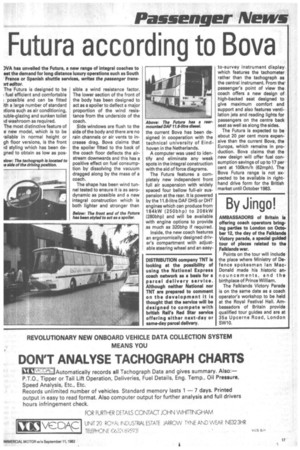Futura according to Bova
Page 11

If you've noticed an error in this article please click here to report it so we can fix it.
:NA has unveiled the Future, a new range of integral coaches to eet the demand for long distance luxury operations such as South France or Spanish shuttle services, writes the passenger transt1 editor.
The Futura is designed to be fuel efficient and comfortable . possible and can be fitted ith a large number of standard ytions such as air conditioning, )uble-glazing and sunken toilet id washroom as required.
The most distinctive feature of e new model, which is to be ■ ailable in normal height or gh floor versions, is the front Id styling which has been degned to obtain as low as pos sible a wind resistance factor. The lower section of the front of the body has been designed to act as a spoiler to deflect a major proportion of the wind resistance from the underside of the coach.
Side windows are flush to the side of the body and there are no rain channels or air vents to increase drag. Bova claims that the spoiler fitted to the back of the coach floor deflects the airstream downwards and this has a positive effect on fuel consumption by dissolving the vacuum dragged along by the mass of a coach.
The shape has been wind tunnel tested to ensure it is as aerodynamic as possible and a new integral construction which is both lighter and stronger than
Above: The Future has a rearmounted DAF 11.8-11tre diesel.
the current Bova has been designed in cooperation with the technical university of Eindhoven in the Netherlands.
A computer was used to identify and eliminate any weak spots in the integral construction with the aid of force diagrams.
The Futura features a completely new independent front full air suspension with widely spaced four bellow full-air suspension at the rear. It is powered by the 11.6-litre DAF DHS or DHT engines which can produce from I84kW (2 50bhp) to 20 6kW (280bhp) and will be available with engine options to provide as much as 320bhp if required.
Inside, the new coach features an ergonomically designed driver's compartment with adjustable steering wheel and an easy to-survey instrument display which features the tachometer rather than the tachograph as the central instrument. From the' passenger's point of view the coach offers a new design of high-backed seat designed to give maximum comfort and support and also features ventilation jets and reading lights for passengers on the centre back seat as well as along the sides.
The Futura is expected to be about 20 per cent more expensive than the current Bova, the Europa, which remains in production. Bova claims that the new design will offer fuel consumption savings of up to 17 per cent at 100km/h (62mph). The Bova Futura range is not expected to be available in righthand drive form for the British market until October 1983.












































